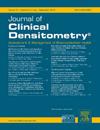Optimal kidney-tonifying traditional chinese medicines for postmenopausal osteoporosis: A network meta-analysis of randomized controlled trials
IF 1.6
4区 医学
Q4 ENDOCRINOLOGY & METABOLISM
引用次数: 0
Abstract
Objective: To evaluate the efficacy and safety of different kidney-tonifying Chinese medicines (KTCMs) combined with bisphosphonates (BPs) in postmenopausal osteoporosis (PMOP) patients.
Methods: This study included 15 randomized controlled trials (RCTs) involving a total of 1,360 PMOP patients to compare the efficacy and safety of various KTCMs combined with BPs. A systematic search was conducted in eight medical databases (CNKI, PUBMED, Web of Science, Cochrane, EMBASE, Wanfang, VIP, and TCM Online). The inclusion criteria were as follows: (1) participants were postmenopausal women with PMOP; (2) the intervention involved different KTCMs combined with BPs; (3) outcome measures included pain Visual Analog Scale (VAS) scores, lumbar spine bone mineral density (BMD), femoral neck BMD, serum osteocalcin levels, and the incidence of adverse events. A network meta-analysis was performed to integrate data, calculating mean differences (MD) with 95 % confidence intervals (CIs). SUCRA values were used to rank treatment efficacy and assess the relative advantages of different regimens. League tables were used to visually present direct and indirect comparisons of treatments, while funnel plots were used to evaluate publication bias. The quality of the included studies was assessed using the Cochrane risk-of-bias tool.
Results: GSK + BPs and JWEX + BPs were the most effective in pain relief, while GSK + BPs showed the best efficacy in improving lumbar spine and femoral neck BMD. LWDH + BPs demonstrated superior performance in promoting bone metabolism. Safety analysis indicated a low incidence of adverse events, with no statistically significant difference between the experimental and control groups (p > 0.05).
Conclusion: This study suggests that GSK + BPs and JWEX + BPs are the most effective combinations for pain relief and BMD improvement, while LWDH + BPs and GSK + BPs have advantages in promoting bone metabolism. The combination of KTCMs with BPs can effectively improve PMOP with high safety, offering significant clinical value.
最佳补肾中药治疗绝经后骨质疏松症:随机对照试验的网络荟萃分析
目的:评价不同补肾中药联合双磷酸盐(BPs)治疗绝经后骨质疏松症(PMOP)的疗效和安全性。方法:本研究纳入15项随机对照试验(RCTs),共1360例PMOP患者,比较各种中药联合bp的疗效和安全性。系统检索了8个医学数据库(CNKI、PUBMED、Web of Science、Cochrane、EMBASE、万方、VIP、TCM Online)。纳入标准如下:(1)研究对象为绝经后绝经期妇女;(2)不同ktcm联合bp干预;(3)结局指标包括疼痛视觉模拟量表(VAS)评分、腰椎骨密度(BMD)、股骨颈骨密度(BMD)、血清骨钙素水平和不良事件发生率。采用网络荟萃分析整合数据,以95 %置信区间(ci)计算平均差异(MD)。采用SUCRA值对治疗效果进行排序,并评估不同方案的相对优势。排位表用于直观地呈现治疗的直接和间接比较,而漏斗图用于评估发表偏倚。使用Cochrane风险偏倚工具评估纳入研究的质量。结果:GSK + bp和JWEX + bp缓解疼痛的效果最好,GSK + bp改善腰椎和股骨颈骨密度的效果最好。LWDH + bp在促进骨代谢方面表现优异。安全性分析显示,不良事件发生率低,实验组与对照组比较,差异无统计学意义(p >; 0.05)。结论:本研究提示GSK + bp和JWEX + bp是缓解疼痛和改善骨密度最有效的组合,而LWDH + bp和GSK + bp在促进骨代谢方面具有优势。中药联合bp可有效改善PMOP,安全性高,具有重要的临床价值。
本文章由计算机程序翻译,如有差异,请以英文原文为准。
求助全文
约1分钟内获得全文
求助全文
来源期刊

Journal of Clinical Densitometry
医学-内分泌学与代谢
CiteScore
4.90
自引率
8.00%
发文量
92
审稿时长
90 days
期刊介绍:
The Journal is committed to serving ISCD''s mission - the education of heterogenous physician specialties and technologists who are involved in the clinical assessment of skeletal health. The focus of JCD is bone mass measurement, including epidemiology of bone mass, how drugs and diseases alter bone mass, new techniques and quality assurance in bone mass imaging technologies, and bone mass health/economics.
Combining high quality research and review articles with sound, practice-oriented advice, JCD meets the diverse diagnostic and management needs of radiologists, endocrinologists, nephrologists, rheumatologists, gynecologists, family physicians, internists, and technologists whose patients require diagnostic clinical densitometry for therapeutic management.
 求助内容:
求助内容: 应助结果提醒方式:
应助结果提醒方式:


